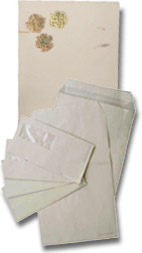
Risk free paper? This is the new challange, after that the FLEGT regulation in Europe, as well as the amended U.S. Lacey Act in the US has already impacted the wood industry, from the investigation of Gibson Guitars to a recently-reported seizure of Peruvian hardwood. Both of these cases involved solid wood products. But what about paper? Paper poses the challenge of linking an illegally harvested tree in a faraway forest to a piece of paper purchased in Europe or in the United States, after all the mixing and bleaching.
Terra!, Rainforest Action Network, Word Resoruces Institute and WWF decided to check out the paper sector, sending ssamples from paper products to independent fiber analysis laboratories. Samples we had tested came from stationery, paper bags, cardboard boxes, toilet paper, facial tissue paper, wrapping paper, and books - including pages, glossy cover sleeves, and cardboard from hardback covers.
With fiber analysis, scientists use high powered microscopes to look at plant fibers and vessels in a snippet of paper to identify what types of trees were used to make it. Vessels are structures that transport nutrients and water in plants, and they have distinct anatomical features that allow for identification of its genus and, in some cases, species.
The tests identified vessels with anatomical features consistent with those of ramin (Gonystylus spp) and of mangrove trees (Rhizophora spp) in children's books from Germany and United States, and of those of Myristicaceae and Dipterocarpaceae family (Dipterocarpus spp) in stationery prodcuts from Pigna, Italy.
Increasingly rare, ramin trees have been protected internationally since 2003 under the Convention on International Trade in Endangered Species of Wild Fauna and Flora (CITES). Likewise, the Indonesian government has imposed an export ban on all ramin products. In other words, ramin fibers should not be found in paper.
Consequently, all these products potentially violate the 2008 amendments to the EU Flegt regulation and the the U.S. Lacey Act, which prohibit trade within the United States of products made from plants that are harvested in contrary to international law or the law of their countries of origin.
Flegt Regulation chain of custody system doesn't apply to books and brochures, but the legality of product containing forbidden species is questionable. In the case of Lacey Act, the prohibition of trade in illegally harvested forest products has applied to paper since May 2008, even though the import declaration does not yet apply to paper
These results demonstrate that it is possible to detect potential violations for paper, thanks to fiber analysis. In addition, they suggest that the prevalence of illegally harvested fiber in paper products may be more common than assumed.
Some NGOs have already used fiber analysis to determine whether books were made from plantation wood or from natural tropical rainforests.
So what can companies in the paper supply chain do to avert the risk of purchasing paper with illegal fiber in i
- Ask questions. Ask your paper supplier questions such as: What is your supply chain? Can you trace the paper all the way back to the forest? What is the degree of illegal activity in that forest or region? What processes do you have in place to prevent illegally harvested fiber from entering your supply?
- Assess risk and respond accordingly. Determine the relative risks associated with the forest of origin. Is the region suspected by credible sources of having high levels of illegal logging? Are civil society campaigns currently underway that indicate that this is a forest of concern? If so, compare the risk of inadvertently sourcing illegal paper to your degree of risk aversion. If responses from your supplier to the questions you ask do not meet your risk tolerance levels, consider sourcing paper from a different supplier or region.
- Adopt a comprehensive forest products purchasing policy. Establish a forest products purchasing policy that reflects company values and incorporates environmental and social safeguards. Such policies can be a good foundation for practicing due care. Training employees on the policy and putting in place systems and performance incentives for policy implementation can effectively reduce risk.
- Purchase certified paper. Harvesting trees legally is a common feature of third-party forest certification programs. Therefore, purchasing certified paper can be a means of demonstrating due care. But note that certification per se does not necessarily mean that the paper is legal, especially if the verification systems of the certification program are not robust and in countries with weak governance. In such circumstances, illegally harvested fibers can still find their way into certified paper.
- Conduct periodic fiber analysis tests. Periodically test samples of paper products you purchase. Periodic testing can reveal what's in your paper and might uncover suspicious fibers and sources. Fiber analysis testing is not expensive, and there are a number of independent fiber testing labs, including:
- Integrated Services carta, Inc. (Stati Uniti) http://ipstesting.com/T401FiberAnalysis/tabid/153/Default.aspx
- Istituto di Paper Science and Technology, Technical University di Darmstadt (Germania) http://www.pmv.tu-darmstadt.de/dienste_pmv/index.en.jsp
- Innventia (Svezia) http://www.innventia.se/templates/STFIPage____6968.aspx
- Econotech (Canada) http://www.econotech.com/services/pulp_paper_test.php


